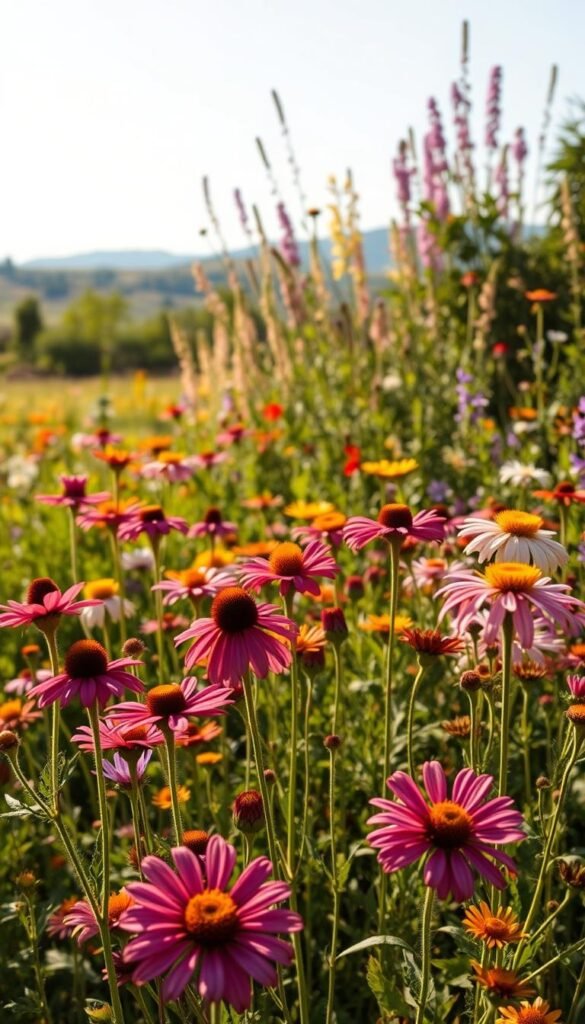Did you know your outdoor space could become a lifeline for bees, butterflies, and other vital creatures? The U.S. Fish and Wildlife Service calls pollinators the “engine” of healthy ecosystems—and they need our help. Even small patches of land, like balconies or neglected corners of a yard, can become thriving habitats that support local wildlife.
Transforming your space isn’t just about beauty. Native blooms filter rainwater, store carbon, and recycle nutrients naturally. These ecosystem services benefit both the environment and your garden’s health. Best of all? You don’t need acres of land or expert skills to make an impact.
This guide will show you how to design a vibrant refuge step by step. Whether you’re planting in pots or redesigning a lawn, you’ll learn to choose flowers that attract pollinators year-round. For inspiration, explore wildflower garden ideas that blend practicality with natural charm.
By nurturing these habitats, you’re joining a larger effort to protect species critical to food production and biodiversity. Every bloom counts—and so does your choice to reconnect with nature right outside your door.
Planning Your Pollinator Paradise
Crafting a thriving habitat starts with smart design choices. Begin by observing your space at different times of day. Note where sunlight lingers longest—most blooms need six hours of direct sun daily. Watch how water drains after rain to gauge your soil type. Sandy spots dry fast, while clay holds moisture longer.
Define Your Vision
Ask yourself: Do you want a low-maintenance meadow or structured beds? Even a balcony can host potted natives like milkweed. Sketch rough zones for seating paths and flower clusters. This makes your garden feel organized without stifling nature’s spontaneity.
Location Essentials
Pick an area sheltered from strong winds—a fence or shrubs work well. Ensure easy access for watering but avoid high-traffic spots where bees might feel threatened. Test drainage by digging a 6-inch hole and filling it with water. If it drains in 1-3 hours, your soil conditions are ideal.
| Factor | Ideal | Adaptable |
|---|---|---|
| Sunlight | 6+ hours daily | 4-5 hours (partial shade) |
| Soil Type | Well-drained | Clay with compost |
| Wind Protection | Natural barriers | Potted windbreaks |
Once you’ve mapped these elements, you’re ready to get started. Remember, flexibility matters—nature thrives when we work with existing conditions, not against them.
Site Preparation and Garden Layout
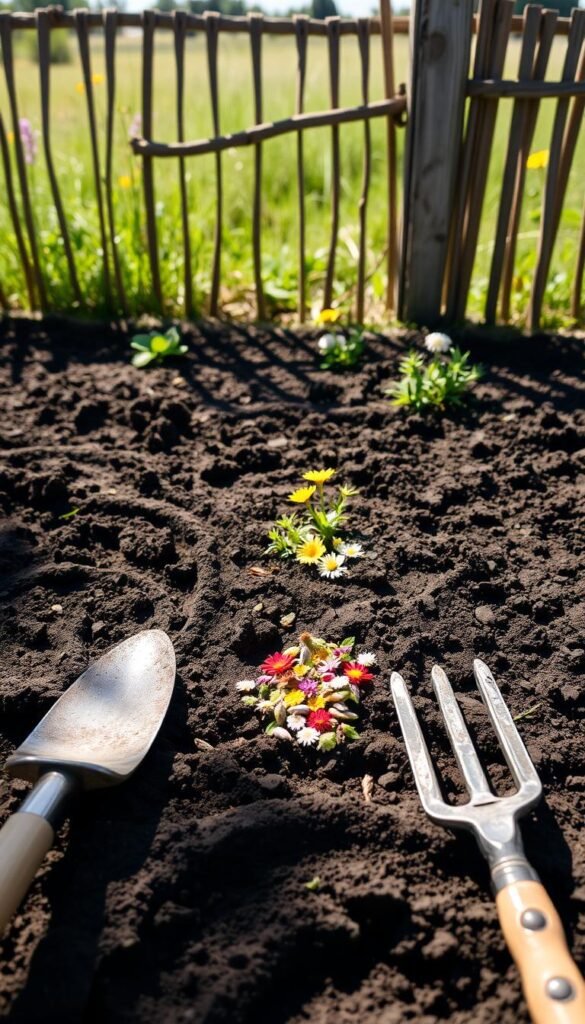
The secret to a thriving pollinator space lies beneath your feet. Proper groundwork ensures your blooms won’t battle invasive grass or stubborn weeds for survival. This phase demands patience—experts call it a “three-year commitment” where the first season focuses solely on creating ideal growing conditions.
Clearing Existing Lawn and Soil Improvement
Start by mowing your area as short as possible. Then, cover it with thick black plastic sheeting from June to September. This smothering method blocks sunlight, killing existing vegetation naturally without chemicals. Here’s why it works:
- Eliminates 90% of competing roots within 12 weeks
- Preserves beneficial microorganisms in the soil
- Prevents new weed seeds from germinating
If plastic isn’t your style, try these alternatives:
- Turn the ground every 3 weeks to exhaust weed reserves
- Plant buckwheat as a cover crop to suppress invaders
Most wildflowers thrive in poor soil, so skip the compost unless your earth resembles concrete. Test drainage by digging a 1-foot hole—water should disappear within 4 hours. For more tips on attracting beneficial insects, explore our guide to creating pollinator-friendly habitats.
Remember: Rushing this stage risks failure. Those first tender seedlings need every advantage to establish strong roots before facing competitors.
Wildflower Wonderland: Creating a Backyard Wildflower Garden for Pollinators
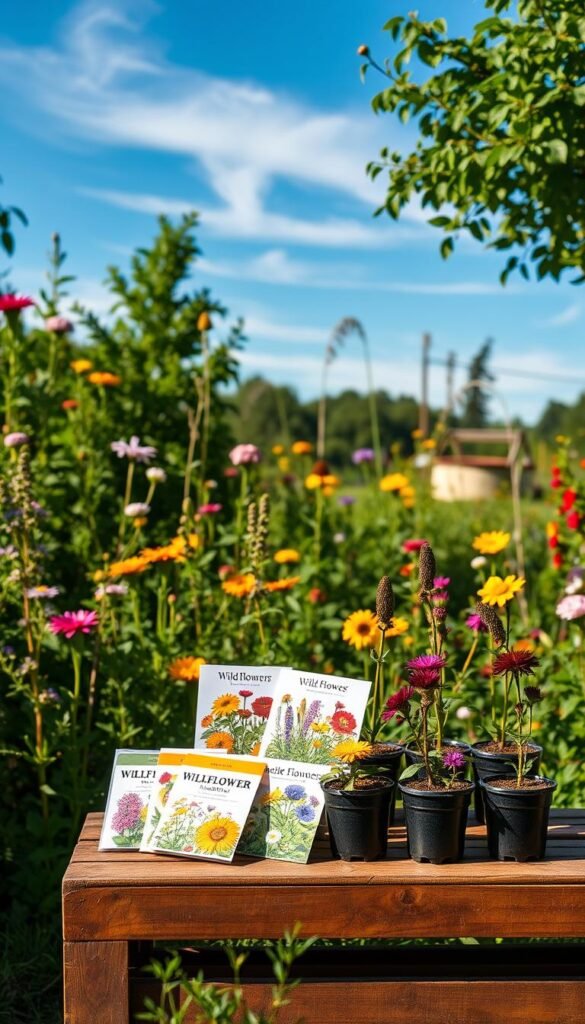
Your journey to a buzzing, blooming sanctuary hinges on two critical choices: how to begin and where to place each element. These decisions shape your garden’s growth speed, costs, and first-year impact.
Deciding Between Seeds and Nursery Plants
Seeds offer affordability—a $5 packet covers 100 square feet. They’re perfect for expansive spaces but demand patience. For best results, scatter them in fall or late winter. Cold temperatures break dormancy naturally, leading to stronger spring sprouts.
Nursery plants, while pricier, deliver instant color. A 4-inch potted coneflower might bloom within weeks, feeding early-season bees. This approach works well for small plots or native plant gardening projects needing quick visual rewards.
Mapping Out Your Garden Space
Sketch your area using simple shapes—circles for clusters, rectangles for pathways. Tall species like sunflowers belong at the back, while low-growing phlox edges paths. Leave 12-18 inches between future plants to prevent overcrowding.
Mark zones for maintenance access and prime viewing spots. A curved bench area facing south ensures you’ll catch butterflies basking in morning light. Remember: Your design evolves as roots take hold and blooms emerge.
Selecting Native Wildflowers and Pollinator-Friendly Plants
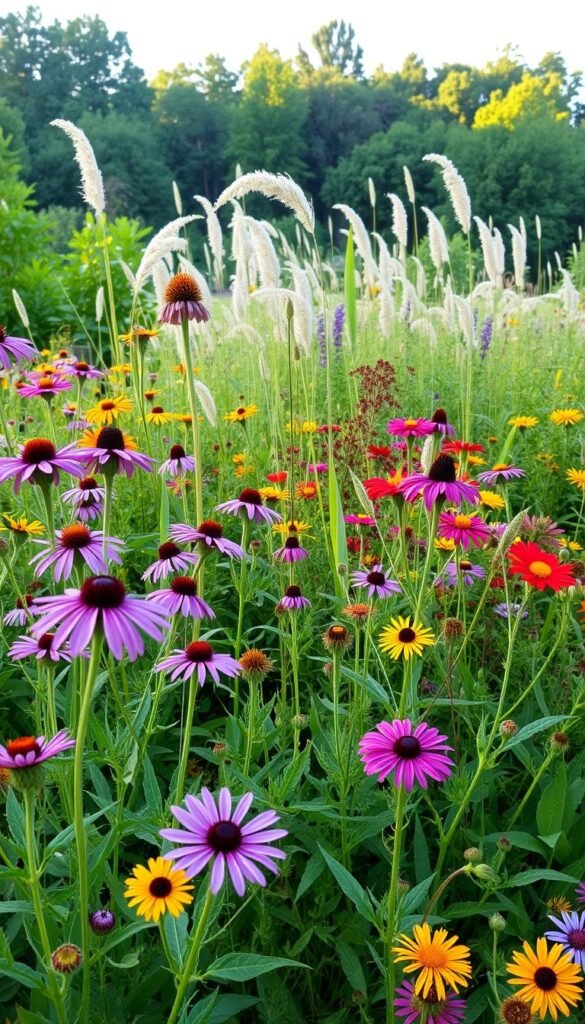
Imagine stepping outside to a living tapestry of color that feeds bees from snowmelt to frost. The key? Choosing species that bloom in staggered waves, creating an unbroken buffet for winged visitors. Start by checking your USDA hardiness zone and local soil maps—these determine which wildflowers will thrive naturally in your space.
Understanding Bloom Sequences for Year-Round Color
Early risers like Virginia bluebells kickstart the season, offering nectar when pollinators emerge from winter dormancy. Mid-summer stars such as purple coneflower take over, while New England asters provide late fall fuel for migrating monarchs. Mix at least 12 perennials to ensure three-season support.
For dry areas, try this proven blend:
- Black-eyed Susan (drought-tolerant, blooms June-September)
- Wild bergamot (loves full sun, attracts hummingbirds)
- Little bluestem grass (adds winter structure)
Always source plants from local nurseries to avoid pesticide-treated stock. Pair taller flowers with low-maintenance blooms for layered beauty that’s both functional and eye-catching. Remember: diversity equals resilience—your meadow should buzz with life from first thaw to final frost.
Planting Techniques for Seed and Nursery Starts
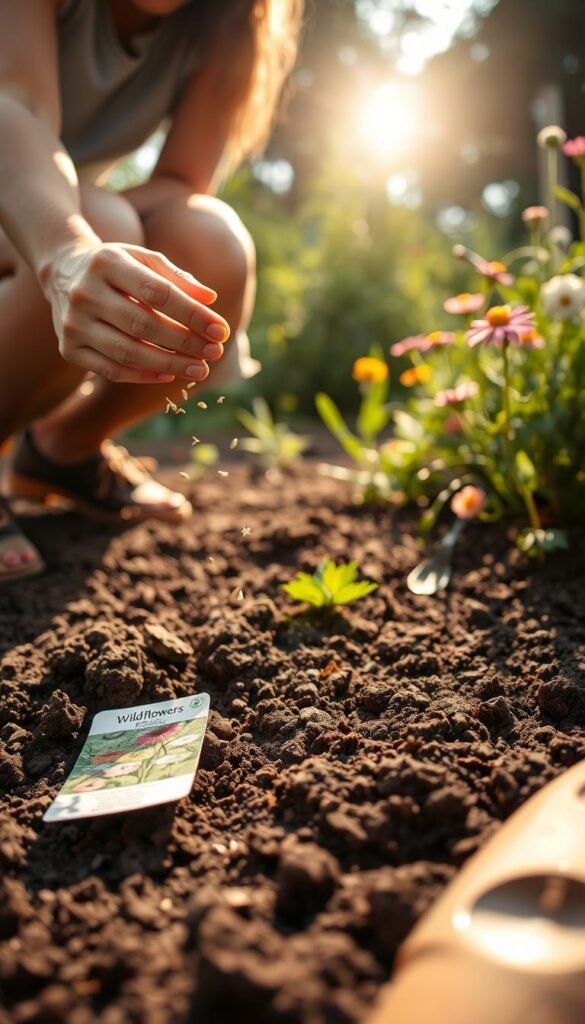
The magic of a pollinator-friendly space comes alive when seeds meet soil and plants find their purpose. Whether you’re scattering tiny specks of life or nestling nursery-grown treasures into the ground, these methods ensure your efforts bloom successfully.
Broadcasting Seeds Evenly with Sand or Carrier Mix
Think of seed distribution as nature’s confetti toss. For small areas, mix 1 part wildflower seeds with 8 parts dry sand—this ratio prevents clumping. Add water gradually until the blend sticks slightly when squeezed. Here’s how pros do it:
- Divide your plot into manageable sections
- Walk north-south while scattering half the mix
- Repeat east-west with the remaining seeds
Lightly press seeds into the soil using a board or your feet. Many varieties need surface contact, not burial—check packet instructions for depth specifics.
Planting Nursery-Grown Specimens with Care
Potted plants offer instant impact but demand gentle handling. Dig holes twice as wide as the root ball, keeping the crown level with the ground. Tease apart tangled roots before placing them in the hole. Backfill with native soil, firming gently to eliminate air pockets.
Water deeply but slowly—a trickle hose works best. For unconventional planting styles that embrace natural chaos, explore urban-friendly wild planting approaches that balance structure with spontaneity.
Seasonal Care: Watering, Weeding, and Mulching
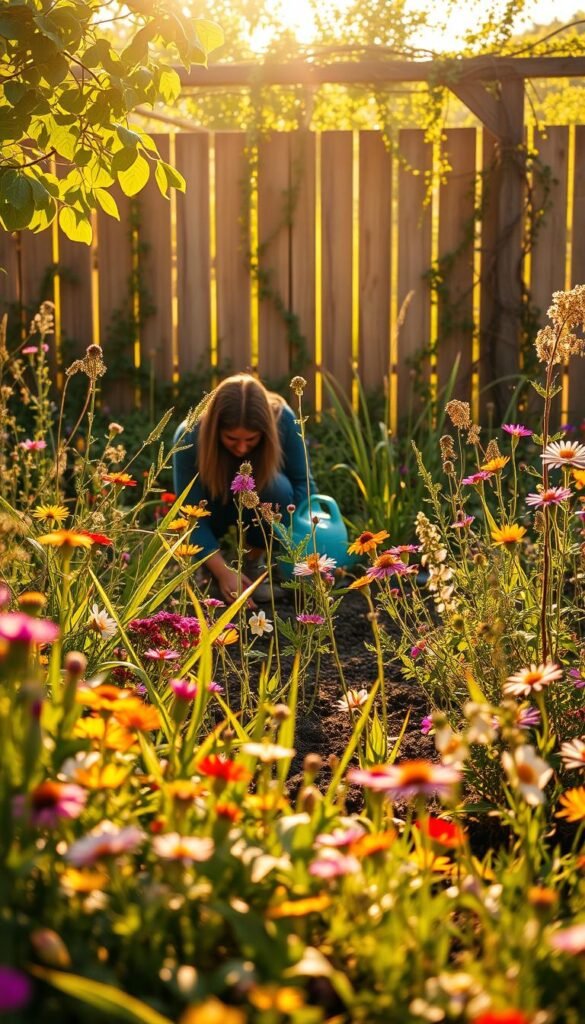
Your blooming sanctuary needs smart maintenance to thrive through changing weather. Timing and technique matter most—especially during the delicate first weeks when seedlings fight to establish roots.
Watering Best Practices for Consistent Moisture
Newly scattered seeds demand water like clockwork. For 4-6 weeks, keep the top inch of soil evenly damp—think of a wrung-out sponge. Water at sunrise when evaporation rates are lowest. If afternoon heat dries the ground, add a light evening sprinkle.
Use a gentle spray nozzle to avoid displacing seeds. Check moisture daily by poking a finger into the soil. Once plants reach 3 inches tall, reduce watering to weekly sessions unless conditions turn bone-dry.
Smart Weeding and Mulch Application
Compete with invaders early but carefully. Identify weeds by their smooth stems and uniform leaves—wildflowers often have fuzzy stalks or jagged edges. Pull intruders after rain when roots slip out easily.
Spread thin layers of straw mulch to block weeds while letting sunlight through. Avoid thick wood chips—they can smother young plants. Replenish mulch each spring to maintain a 2-inch barrier.
| Task | Early Growth | Established Plants |
|---|---|---|
| Watering | Daily light sprays | Weekly deep soak |
| Weeding | Hand-pick weekly | Monthly checks |
| Mulching | Skip until sprouted | Refresh annually |
Adjust routines with the season—spring demands vigilance, while fall focuses on protection. For more tips on avoiding common small-space errors, explore our troubleshooting guide. Remember: a little care today means years of effortless beauty tomorrow.
Creating a Balanced Wildflower Meadow Ecosystem
A thriving meadow isn’t just flowers—it’s a living network where every element plays a role. Native grasses like little bluestem add structure while offering shelter for bees and nesting areas for ground-dwelling insects. These plants stabilize soil and create microclimates, letting delicate blooms flourish nearby.
Why Grasses Matter
Mix 20% grasses with your wildflower selections to support biodiversity. Their deep roots prevent erosion, while seed heads feed birds through winter. For balance, pair them with low-growing companions like yarrow or goldenrod—these fill gaps without overshadowing showy blooms.
Consider adding clump-forming species such as switchgrass. They provide hiding spots for butterflies during storms and perches for dragonflies hunting pests. This layered approach mimics natural prairies, creating resources for every stage of a pollinator’s life cycle.
Your meadow becomes a sanctuary when you embrace structured chaos gardening principles. Let self-seeding annuals mingle with perennials, and watch as your wildflower garden evolves into a resilient habitat. Every plant choice strengthens this web of life—one bloom, blade, and beetle at a time.

